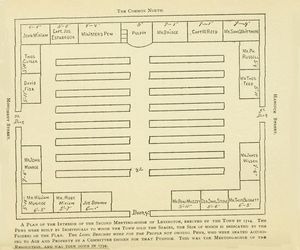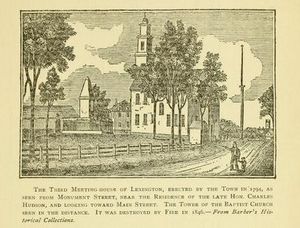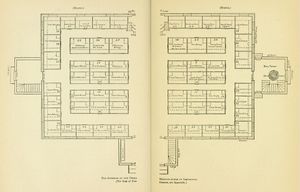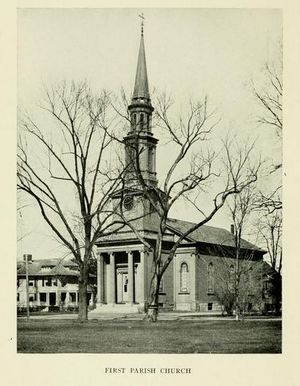Old Churches and Meeting Houses in Lexington
| In And Around Lexington |
|---|
| Events |
| Events and Calendars |
| Arts and Entertainment |
| Art Galleries, Cary Library |
| Museums |
| Historical Buildings and Sites |
| Bands |
| Orchestras, Symphonies |
| Local Flora and Fauna |
| Ballet, Opera, Theater |
| Trees, Shrubs and Vines |
| Wild Flowers and Herbs, Birds |
| Local History |
| Articles, Books, Old Pictures |
| Historic Commission, Historic Surveys |
| Old Churches and Meeting Houses |
| Period Maps, TV Stations, Web Site Mirrors |
| Recreation and Outdoors |
| Biking, Exercise, Gyms |
| Parks, Trails |
| Town Recreation Facilities |
| Food and Drink |
| Restaurants |
| City Life |
| Mailing Lists, Web Sites, FAQs |
| Churches and Temples |
| Child Care Centers |
| Public, Private Schools |
| Tutoring and Private Instructors |
First Meeting House
Erected 1692, after farmers at Cambridge Farms petitioned the General Court to be made a separate parish, with their own church and minister. The Town of Lexington was incorporated in 1713.
Second Meeting House
The plan on the left is that of the Second Meeting House, erected 1714. It stood on the Lexington Green at the time of the Revolution.
Third Meeting House
Built in 1794, in the Lexington Common, with the Tower towards the Concord end. It was painted "a pea green", by consent of Town Meeting, but the interior was not painted, and no pew was allowed to be painted "without consent of the town".
The enclosing fence probably dates from after 1820. In the 1830s, two other churches were established in Lexington (First Baptist, and the Church at East Lexington, the latter now called Follen Church, built in 1840 and designed by Charles Follen).
Around 1845-46, the First Parish was incorporated as First Congregational Society of Lexington, and separated itself from the town. "Up to that time", C.A. Staples writes, all church business affairs, "the calling of a minister, the payment of his salary, the repairs upon the meeting-house were conducted under town warrants, in town meeting, giving rise to endless bickering and strife." Old Town Hall, later to function as high school, was built in 1846.
The third meeting house was repaired and refurnished, and as it was ready to be rededicated, it burned to the ground on Dec. 17, 1846. The Baptist Society allowed graciously use of its house to the congregation until the fourth meeting house was erected.
Old Town Hall
First Parish Church - Fourth Meeting House
It was built in 1848, on Elm St, and is still standing today. The vestry is an 1878 addition, with further extension work completed in 1908. A three manual organ, built by George S. Hutchins, was installed in 1898, behind the pulpit.
Books, Articles and Resources
- The Second Meeting House in Lexington, erected by the Town in 1814, in Proceedings of the Lexington Historical Society, Vol. 1, p. 129.
- A Sketch of the History of the Lexington Common, read by C. A. Staples, Oct 16, 1886, in Proceedings of the Lexington Historical Society, Vol. 2, p. 16.
- History of the Stone Building, read by E. Bradford Smith, Dec 12, 1893, in Proceedings of the Lexington Historical Society, Vol. 2, p. 144.
- The Parish of Cambridge Farms, read by Rev. C.A. Staples, Dec. 8, 1891, in Proceedings of the Lexington Historical Society, Vol. 3, p. 24.
- Architectural Yesterdays in Lexington, a fragmentary account of some of the older buildings and their builders, by Dr. Fred Smith Piper, read Oct 15, 1908, in Proceedings of the Lexington Historical Society, Vol. 4, p. 119.
- File:Municipal-buildings-report.pdf, prepared by Bargmann Hendrie + Archetype, Inc (Sept 21, 2011).




